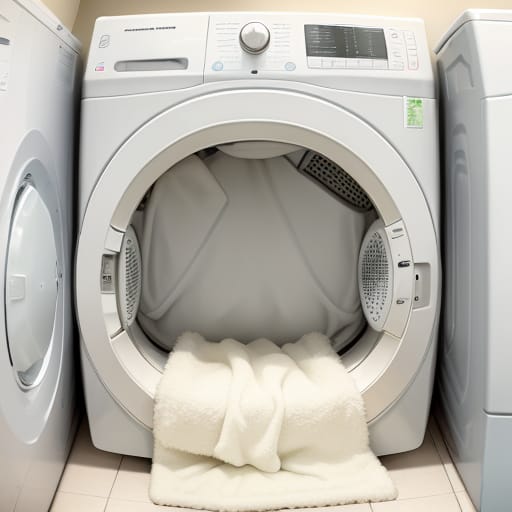You slide under your favorite goose-down comforter after a long day. This fluffy, warm duvet insert feels like a comforting hug, enveloping you with its plushness and loft. You drift off, waking hours later covered in sweat. Then it hits you – your cherished down comforter could use a wash. But can you machine wash such a prized bedding essential?
The short answer – yes! With the right techniques and care, you can refresh your goose-down comforter at home. But misconceptions abound about proper cleaning methods. Follow this beginner’s guide to learn:
- The benefits of washable down
- Which materials impact washability
- Care and maintenance best practices
- Quality standards for longevity
- Choosing the right duvet cover
- Industry trends and future innovations
Arm yourself with facts. Then rest easy under your freshly laundered goose-down comforter many cozy nights to come.
Down Comforters: Fluffy, Breathable Warmth Year-Round
A goose down comforter consists of an outer fabric shell stuffed with the fine, fluffy undercoat from ducks or geese. This superior natural insulation offers:
- Lightweight warmth without weight
- Luxurious softness and billowy thickness
- Breathability to regulate body temperature
The result? A comforter that provides welcoming warmth and insulation, with plenty of plushness and loft. One that excels across seasons to guarantee cozy sleep all year long. Even better, goose down offers long-lasting comfort and durability when properly cared for.
Why “Machine Washable” Matters
As you snuggle under the luxurious softness of your goose down comforter night after night, it inevitably collects sweat, oils, and dirt. Not to mention occasional spills or “accidents” from kids or pets.
While nothing beats these cloud-like cozy comforters for warmth and plushness when new, they require care to maintain. Traditionally, cleaning meant:
- Pilgrimages to expensive specialty dry cleaners
- Harsh chemicals that degrade delicate down and fabrics
- Shrinking, clumping, and damage from improper washing
Enter the modern machine washable down comforter! Thanks to advances in fabrics and construction, you can now clean your comforter at home with ease.
Follow our washing, drying, storage, and cleaning tips to extend the lifespan of your beloved bedding. Keep your down fresh, fluffy, and free of allergens and irritants.
Down Comforter Anatomy: Shells, Fills & Thread Counts
To understand washability, let’s peek inside the construction:
Shell Fabric Matters
An Egyptian-quality cotton shell woven tightly with a 600 thread count makes for luxury bedding. But lower thread counts of 200-400 perform fine too. The key is using a durable, breathable fabric less prone to wearing thin over frequent wash cycles.
Cotton works best. Poly-cotton blends add softness at an affordable price point. But all-polyester compromises on breathability.
It’s What’s Inside That Counts
Goose down still reigns supreme for providing the most lightweight warmth and plushness. But goose-down alternatives, like siliconized fibers offering heightened lofts, also now exist.
Alternative synthetic fills make for cheaper options but frequently fall short on warmth and longevity.
Inner Workings for Even Distribution
Inside, baffle box construction with breathable fabric dividers ensures even insulation distribution. This prevents cold spots when downshifts after washing.
Corner tabs also secure the comforter in a duvet cover. So it stays neatly in place over time and cycles.
Top 5 Perks of Machine Washability
Why invest in a machine-washable down comforter? Here are 5 compelling benefits:
1. Allergen-Free Healthy Sleep Environment
For those with sensitivities, unwashed down can trigger reactions from the buildup of dust mite droppings. Frequent cleaning deters these and other allergens. So you enjoy restful, healthy sleep without worry of irritation or congestion.
2. Deters Growth of Harmful Bacteria
Sweat and humidity create a breeding ground for bacteria inside bedding. But washing with hot water and hypoallergenic detergents kills germs lurking inside your cozy cocoon.
3. Preserves Longevity of Materials
Soaking up oils from the skin compromises down’s warming capacities over time. Like clothes, washing maintains the long-lasting comfort and insulation integrity your comforter was designed for.
4. Convenience of At-Home Care
Skip trips to the dry cleaners! Save time and money by conveniently washing at home as needed for a warm, clean, and cozy bed all year long.
5. Better for the Environment
At-home washing reduces the carbon footprint associated with transporting bedding to and from professional cleaners. Choosing eco-friendly detergents takes green cleaning one step further.

Washing: Best Practices for Down Comforter Care
Contrary to popular belief, you can successfully clean your goose down comforter at home. Here’s how step-by-step:
Before Washing:
- Always check manufacturer instructions on care labels first
- Close zippers; velcro duvet cover hooks
- Wash with mild, hypoallergenic detergent
- Choose a normal or delicate cycle
During the Wash:
- Use hot water to kill dust mites; warm water lessens agitation
- Add tennis balls to the drum to prevent clumping
- Optional extras: scent-free bleach/vinegar to brighten
Drying Tips:
- Tumble dry low, 3-5 tennis balls helps maintain loft
- Remove promptly; air dry remainder to prevent overdrying
Repeat washes every 6 months – 1 year to remove lingering odors, sweat, and allergens for the healthiest night’s sleep.
Keeping Your Down Comforter Clean
Extend your investment with proper maintenance between washes:
- Spot clean stains immediately with a damp cloth
- Fluff monthly to prevent matting in the duvet
- Airing out for several hours restores the loft
- Natural light also helps keep filling fresh
- Store in breathable cotton during warmer months
- Dry clean only if home washing fails or for stubborn odors
Avoid soaps containing optical brighteners. These chemicals strip natural oils that protect delicate feathers.
What Makes It Machine Washable? Quality Counts
Not all down comforters live up to their “washable” claims. Before buying, look for indicators of washable quality:
- Fill power of 600 or higher
- Certifications like Oeko-Tex and RDS
- Reinforced stitching and durable shell fabrics
- Manufacturer guidance for maintenance
Higher fill power ratings typically withstand washing better with less shrinkage. Certified products also meet strict standards for safety and durability.
Finding the Right Duvet Cover
Even with a durable comforter, a duvet cover protects from spills and stains in between washes. Features to look for include:
- Snug fit with hidden zippers, ties, or corner loops
- Buttons, corner tabs, or ties to secure a comforter
- Materials that breathe to prevent dampness
- Designs and colors suiting your décor
Choose a cover made from natural fabrics like cotton or linen for the highest quality sleep experience.
The Future of Machine Washable Comfort
Exciting advances make home care even more accessible:
- Improved moisture-wicking breathable fabrics
- Recyclable materials and sustainable production methods
- Adjustable fill levels for custom comfort and washability
- Mobile apps syncing with smart sensors to track usage patterns and suggest ideal cleaning cycles
The possibilities indicate goose-down comforters will only become easier to clean and care for over time.
Common Concerns and Questions
Still harbor washing worries? We debunk some common myths:
Will it shrink my down comforter?
Quality comforters pre-treated to reduce shrinkage can handle home washing without issue. Taking needed precautions like low heat drying prevents excessive shrinking.
Is dry cleaning better?
While still an option for serious soiling issues, dry cleaning involves harsh chemical solvents that damage fabrics and feathers over time. Gentle home washing is typically safer and cheaper.
Isn’t it challenging for amateurs?
Advances in fabrics along with the care tips above make home washing your comforter attainable for all. Thousands of happy customers wash their comforters with excellent, lasting results.

Lasting Luxury Within Reach
Why suffer with a stained and smelly goose-down comforter when you could rest soundly wrapped in freshly laundered warmth and comfort? As this guide reveals, extending your bedding’s lifespan through home care is possible.
Implement these best practices for washing, drying, airing and spot-cleaning your beloved down-filled blanket. Then look forward to smooth, breathable fabrics enveloping you for the ultimate soothing night’s sleep, year after year.
Frequently Asked Questions
What is the best way to wash my goose down comforter at home?
Use a mild, hypoallergenic detergent and wash on a delicate cycle in hot water. Add a few tennis balls to the drum to prevent clumping and aid in fluffing. Tumble dry low with tennis balls then promptly remove and air dry the remainder to prevent overdrying.
How often should I wash my down comforter?
Aim to wash your down comforter every 6 months to 1 year. This removes built-up sweat, body oils, dust mites, and other allergens for the healthiest sleep environment. Spot clean stains in between washes as needed.
What’s the ideal thread count for a down comforter shell?
While Egyptian-quality cottons with 600 thread counts make luxury bedding, cheaper cotton-poly blends around 200-400 thread counts perform fine too. Focus more on choosing a lightweight, breathable, and durable fabric.
What fill power rating indicates the highest quality down?
Look for a fill power of 600 or higher. This number refers to the loft and insulation capacity of the down fill. Higher fill power downs can better handle frequent wash cycles with less shrinking or clumping.
Is it better to dry clean my down comforter instead?
No. While dry cleaning is still an option for serious stains, the harsh solvents used can degrade fabrics and down over time. When done properly, washing at home is the cheaper and gentler method for cleaning your duvet insert.
How do I know if my comforter is truly machine washable?
Quality indicators to look for include high fill power ratings of 600+, Oeko-Tex/RDS certifications, reinforced shell stitching with durable fabrics, and manufacturer guidance for washing maintenance.
What features should I look for in a duvet cover?
Choose a duvet cover in natural, breathable fabrics like cotton or linen. Seek out one with sturdy corner ties/tabs, hidden zippers or button closures to secure your comforter inside. This prevents shifting while protecting from wear and tear during washing cycles.








